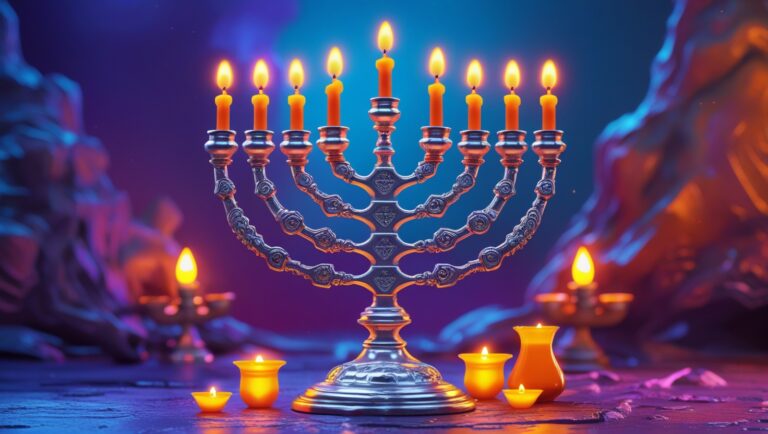Most people are aware of the idea of “seeing God in everything”. However, in practical terms, this concept is still very obscure.
If one suddenly starts “seeing God in everything”, what then? Should you do something about it? Is it good? What benefits do you get from that?
On a very simple level, we can all agree that everything is a manifestation of God and that everything is for the best, but what can we learn from mundane observation? Is there a system by which we can know what to do and whether Hashem is happy with us?
Luckily there are methods of interpreting reality as we will see.
Many people call it synchronicity and serendipity. There’s a similar concept in Judaism when it comes to Hashgacha (divine providence). What I like about English is that we can understand Hebrew ideas better when they are translated, even though we lose a lot in the translation.
Understanding synchronicity from a Kabbalistic point of view
Synchronicity is defined as the occurrence of meaningful coincidences or events that are seemingly unrelated but are connected by their significance or meaningfulness to the observer. The English term was introduced as a concept by Swiss psychologist Carl Jung but since it was second nature to our sages, they probably didn’t feel the need to create a term for it.
Synchronicity then represents the simultaneous occurrence of events that cannot be explained by conventional causality but are instead linked by their meaning or significance. These events often involve a coincidence of outer circumstances with an individual’s inner state of mind, emotions, or thoughts.
For example, my mentor from Bnei Brak once said that whenever you are studying different books and happen to, on the same day, reach the same ideas in them (or even the same verses), that means that the study is very much desired by Hashem. Hashem would not put the very same idea in different works for no reason. And the reason is that, when this happens, He’s happy with us.
Note that one doesn’t need to be at the level of Yosef HaTzadik or other sages to experience that.
But there’s another way we can experience synchronicity, and that, writes R’ Chaim M’Volozhin, happens when you have a big question in your mind, and go to study Torah. It could be that you read the answer you need, or the answer “falls” in your mind because the Torah gives you the way to follow.
So, while we don’t have a Hebrew term for Synchronicity, it can manifest as a series of coincidences, symbolic encounters, or even dreams that align or are related to your current life situation, aspirations, or psychological state.
This shouldn’t be a surprise since the spiritual worlds generate a series of contractions until we reach our physical state, and Hashem is guiding them (and us) toward our ultimate Tikkun. It is then in His interest that we pick up the tips and read the signposts that are guiding us. Knowing this (and being mindful of the signs) can be a great help.
Remember: the signs are there if we are mindful of them.
Understanding serendipity from a Kabbalistic point of view
Serendipity is defined as the occurrence of valuable or fortunate discoveries or events by chance, often when one is not actively seeking them. It refers to the ability to find something valuable, useful, or pleasant while looking for something else entirely, or even without any specific intention at all.
I guess the word for serendipity would be “אשרי” in Hebrew (or blessing?) but that doesn’t convey the meaning of being “surprisingly happy by a fortunate series of events”. The concept of serendipity was first coined by Horace Walpole in the 18th century, inspired by a fairy tale called “The Three Princes of Serendip.” In the story, the princes frequently made unexpected discoveries and solved problems through accidental and fortunate circumstances.
We all have times in our lives when “things seem to go our way” or we are “lucky” (though we all know there’s no such thing as “luck”). In Kabbalistic terms, it means that our Mazal has just risen. Mazal is the series of channels of shefa (abundance, including wealth, health, wisdom and so on) that a person needs to fulfil his spiritual work. Sometimes the Mazal is on the drier side because one needs to work through situations of “dinim” to rectify for a particular sin in this lifetime or the previous.
But bad times are never forever and serendipitous events are characterized by their unexpectedness and the positive outcome they bring.
As Rabbi Shalom Sharabi divides the system of Avodah in Partzufim (spiritual systems), whenever a system is complete, we so to speak “graduate” and then receive gifts (including the Sephira of Keter). As we explained in another article, there are many Partzufim operating at the same time. A system may take place in a single Tefila, a single study session, a single Mitzvah or it may take the Jewish year or the 49 years of Yovel. These systems are all operating simultaneously.
Either way, serendipity can take many forms, such as stumbling upon a solution to a problem while engaging in an unrelated activity, meeting someone influential or important through a chance encounter, or discovering a valuable piece of information while researching a different topic.
Of course, all of this is from Hashem and, like synchronicity, it’s meant to teach something. This something is particular to the individual to whom these events pertain. The way to “translate” it into instruction is through Hitbodedut or meditation. You can, for example, try out the heart meditation whenever this happens.
Some say that while serendipity is based on chance (i.e. Mazal), it is also influenced by an individual’s preparedness, knowledge, and receptiveness to new experiences. Cultivating an attitude of openness, curiosity and mindfulness can enhance the likelihood of serendipitous encounters and allow individuals to recognize and make the most of unexpected opportunities that come their way.
How to start seeing God in everything
I’d say the ability to start seeing synchronicity and serendipity depends on how close one is to Hashem. This can be achieved not only by fulfilling the Mitzvot but I believe needs to be complemented with Hitbodedut and Jewish meditation. Through Hitbodedut one asks for clues, while through meditation one opens up his mind to become more aware of the signs.
Let’s be clear: the entire Creation is a projection of Hashem’s will. It follows therefore that everything we see happening is meant to convey us something.
The fact that we are here and not there, that we are 5 minutes late for an appointment, that we can’t find the cereal we want in the supermarket, that we get sick or anything else really is 100% from Hashem. Whether we can interpret events require training, but is easier for major events.
Hashem is always guiding world events behind the many veils which we call spiritual worlds. Synchronicity in Kabbalah can be seen as a manifestation of the interconnectedness and interdependence of all aspects of creation. Nothing simply “happens”.
Other remarks
One of the most important things I’d say about all this is that seeing God in everything requires one to ask specifically about it. Hashem wants to have a relationship with us, but it must be predicated on our openness to receive his guidance.
Serendipity and synchronicity are built-in rules of Creation. We can all use it to our advantage if we simply learn to open our minds and learn how to interpret events.
Sometimes the answer doesn’t come in a clear cut way, after all we are not prophets. But even we can learn to interpret the signs and learn how to receive guidance from the events around us.
Hashem already made Creation in a way that we are guided toward our Tikkun.
So it’s up to us, really.







